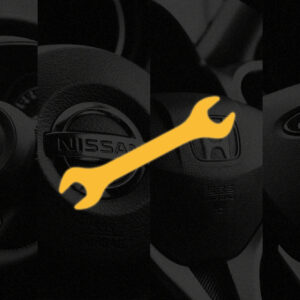The warning lights on your dashboard help you determine when it’s time to take a trip to an auto repair shop. If your emission system warning light activates while driving, don’t ignore it. This warning light can signal an issue within your emission control system.
Why Is My Check Emission System Light On?
The check emission system light is meant to alert you that there’s a faulty component affecting your ride’s emission control. The bad part could be an oxygen sensor, a catalytic converter, a loose gas cap, or other critical engine components.
This warning light can also illuminate if there’s an external factor causing your emissions to go beyond their normal range.
Most vehicles manufactured from the year 1996 onwards do not have a “check emissions system light.” Instead, the check engine light will illuminate once there’s an emission-related fault.
Any fault that triggers the check engine light is considered emission-related because these issues impact the vehicle’s performance and emission output. Diagnostic trouble codes can also be logged once the light turns on.
Any fault that triggers the check engine light is considered emission-related because these issues impact the vehicle’s performance and emission output.
–Anthony Harlin, ASE Certified Master Automobile Technician
On vehicles manufactured before 1995, the check emissions light will turn on as soon as the problem is detected. It’ll turn off once the problem is fixed.
Common Triggers of the Emission System Warning Light
Let’s take a closer look at the common causes of an illuminated check emission light.
Loose Gas Cap
You’re lucky if the cause of a lit check emission light on your ride is just a loose gas cap.
When your gas cap isn’t tightly sealed, fuel vapors could escape the fuel tank. Any leak affecting the evaporative emission control (EVAP) system can be detected by the vehicle’s computer.
If a loose gas cap is the culprit, you can’t just tighten it to solve the issue. You’ll have to test it multiple times before the check emission light turns off. Check the gas cap for any form of damage while you’re at it. Replace it if you notice any cracks, as dirt and grime can enter the tank through the break and cause a plethora of issues.
Clogged Air Filter
Although it doesn’t directly affect your ride’s emissions, a clogged air filter can decrease engine performance. That’s because a dirty air filter can restrict airflow to the engine and cause an imbalance of air and fuel. The imbalance can cause certain warning lights to illuminate—including the check emission light.
Bad Catalytic Converter
A worn-out catalytic converter can also cause your check emission light to come on. This component converts harmful pollutants and gasses into less harmful substances before releasing them into the atmosphere.
Like other vehicle components, your catalytic converter can fail over time, resulting in harmful emissions.
Failed Oxygen Sensor
The oxygen sensor measures how much oxygen is in the exhaust gases. It sends the data to the powertrain control module (PCM) so that it can adjust the air-to-fuel mixture in the engine accordingly.
A malfunctioning oxygen sensor can send inaccurate readings to your ride’s control module, causing an imbalance of oxygen and fuel in the engine.
Other Faulty Engine Sensors
Your check emission light can illuminate once any of your engine sensors are bad. It can be difficult to determine which engine sensor is causing the issue. You can use an OBD scan tool to spot where the issue is coming from, so you’ll have an idea of what repair to do.

Why Does My Check Emissions Light Go and Off?
If your check emission light goes on and off, it can mean that the issue is intermittent. There might be a rapidly changing condition affecting your vehicle’s emission control. Have your ride inspected by a mechanic as soon as possible.
Is It Safe to Drive with the Check Emission Light On?
Technically, you can still drive your vehicle even if the check emissions light is on. However, it’s not recommended.
Remember that there are several possible reasons why this warning light illuminates, so you won’t know how severe the engine issue is without a proper diagnosis. If you continue to ignore this warning, you’ll risk damaging your engine.
Can a Check Emission Light Illuminate for No Reason?
Yes. There can be instances when your check emission warning light illuminates even if there are no issues involving your vehicle’s emission control. This problem is usually related to your ride’s computer calibration.
How Can I Prevent Emission System Problems?
You can prevent emission control issues by following your ride’s regular maintenance schedule. Doing so will help you detect problems before they get worse. For example, regular tune-ups and air filter replacements will help keep your emission control system from failing.
You can also prevent emission-related problems (and improve engine performance) by using high-quality fuel for your ride. Making sure your gas cap is tightly secured whenever you refuel your ride also helps.
Diagnosing an Emission System Problem
If you’re not sure how to diagnose the issue, it’s best to leave the job to a trusted mechanic.
Here’s what it generally involves.
Checking the Gas Cap
If it’s loose or damaged, tightening or replacing it could deactivate the lit check emission light.
Retrieving Error Codes
Mechanics use an OBD scan tool to retrieve the error codes logged in the vehicle’s computer (if there are any).
Trouble codes usually indicate what’s causing problems in the vehicle. For example, if the retrieved error code relates to an oxygen sensor, checking and addressing the issues in that part could resolve the problem.
Any information provided on this Website is for informational purposes only and is not intended to replace consultation with a professional mechanic. The accuracy and timeliness of the information may change from the time of publication.

















